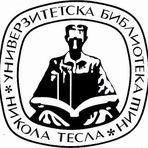Title
Analiza simptoma i funkcionalnih rezultata nakon radikalne zračne terapije, laparoskopske radikalne prostatektomije i retropubične radikalne prostatektomije u lečenju lokalizovanog karcinoma prostate
Creator
Shabani, Bashkim, 1977-
CONOR:
103143177
Copyright date
2024
Object Links
Select license
Autorstvo-Nekomercijalno-Bez prerade 3.0 Srbija (CC BY-NC-ND 3.0)
License description
Dozvoljavate samo preuzimanje i distribuciju dela, ako/dok se pravilno naznačava ime autora, bez ikakvih promena dela i bez prava komercijalnog korišćenja dela. Ova licenca je najstroža CC licenca. Osnovni opis Licence: http://creativecommons.org/licenses/by-nc-nd/3.0/rs/deed.sr_LATN. Sadržaj ugovora u celini: http://creativecommons.org/licenses/by-nc-nd/3.0/rs/legalcode.sr-Latn
Language
Serbian
Cobiss-ID
Theses Type
Doktorska disertacija
description
Datum odbrane: 18.6.2024.
Other responsibilities
Academic Expertise
Medicinske nauke
University
Univerzitet u Nišu
Faculty
Medicinski fakultet
Group
Katedra za radiologiju, nuklearnu medicinu i osnovi kliničke onkologije
Alternative title
Analysis of symptoms and functional results after radical radiotherapy, laparoscopic radical prostatectomy and retropubic radical prostatectomy in the treatment of localized prostate cancer
Publisher
[B. G. Šabani]
Format
220 listova
description
Biografija autora: list [221]
Bibliografija: list. 148-199
description
Urology
Abstract (en)
Adverse effects of active treatment for localized prostate cancer (LPCa), including laparoscopic radical prostatectomy (LRP), retropubic radical prostatectomy (RRP), and radical radiation therapy (EBRT), refer to symptoms and functional disorders in the urinary, sexual and bowel domains. The aim of the study was to compare the outcome parameters of active treatment in patients with LPCa. A total of 140 patients with LPCa were included in the study, divided into three groups, according to the applied therapeutic procedure (LRP group - 50; RRP group - 50; EBRT group - 40). Demographic and clinical parameters, perioperative and pathological results, operative complications, as well as symptomatic and functional results were analyzed. EPIC-26, IPSS, ICIQ-UI SF and IIEF guidelines were used to assess symptoms. A urodynamic test was performed to assess the functional outcomes. Data were collected from subjects before the
start of treatment, as well as during the follow-up period, after 3, 6, 12 and 24 months. Operative time was shorter in the RRP group. Bleeding, length of hospitalization, and time to removal of urinary catheter were lower in the LRP group. The incidence of positive resection margins did not differ between the studied groups. There is a significant interaction between time and group for all urinary and bowel domains, as well as a significant effect of time for all sexual domains. After 6, 12 and 24 and 36 months, there are significant differences between all urinary domains (except UIO) in favor of the EBRT group. IPSS and ICIQ-UI SF are statistically significantly different between groups in favor of the EBRT group (IPSS at 6 months, ICIQ-UI SF throughout the follow-up period). IIEF values differ significantly in the follow-up period. Among therapeutic procedures, there are no significant differences regarding the oncological treatment outcomes and the impact on the sexual domain. LRP and RRP have the most pronounced influence on the urinary domain. EBRT has the most pronounced effect on the bowel domain.
Authors Key words
karcinom prostate, radikalna zračna terapija, laparoskopska radikalna prostatektomija, retropubična radikalna prostatektomija
Authors Key words
prostate cancer, radical radiation therapy, laparoscopic radical prostatectomy, retropubic radical prostatectomy
Classification
616.65-006.6-089(043.3)
Subject
B 560
Type
Tekst
Abstract (en)
Adverse effects of active treatment for localized prostate cancer (LPCa), including laparoscopic radical prostatectomy (LRP), retropubic radical prostatectomy (RRP), and radical radiation therapy (EBRT), refer to symptoms and functional disorders in the urinary, sexual and bowel domains. The aim of the study was to compare the outcome parameters of active treatment in patients with LPCa. A total of 140 patients with LPCa were included in the study, divided into three groups, according to the applied therapeutic procedure (LRP group - 50; RRP group - 50; EBRT group - 40). Demographic and clinical parameters, perioperative and pathological results, operative complications, as well as symptomatic and functional results were analyzed. EPIC-26, IPSS, ICIQ-UI SF and IIEF guidelines were used to assess symptoms. A urodynamic test was performed to assess the functional outcomes. Data were collected from subjects before the
start of treatment, as well as during the follow-up period, after 3, 6, 12 and 24 months. Operative time was shorter in the RRP group. Bleeding, length of hospitalization, and time to removal of urinary catheter were lower in the LRP group. The incidence of positive resection margins did not differ between the studied groups. There is a significant interaction between time and group for all urinary and bowel domains, as well as a significant effect of time for all sexual domains. After 6, 12 and 24 and 36 months, there are significant differences between all urinary domains (except UIO) in favor of the EBRT group. IPSS and ICIQ-UI SF are statistically significantly different between groups in favor of the EBRT group (IPSS at 6 months, ICIQ-UI SF throughout the follow-up period). IIEF values differ significantly in the follow-up period. Among therapeutic procedures, there are no significant differences regarding the oncological treatment outcomes and the impact on the sexual domain. LRP and RRP have the most pronounced influence on the urinary domain. EBRT has the most pronounced effect on the bowel domain.
“Data exchange” service offers individual users metadata transfer in several different formats. Citation formats are offered for transfers in texts as for the transfer into internet pages. Citation formats include permanent links that guarantee access to cited sources. For use are commonly structured metadata schemes : Dublin Core xml and ETUB-MS xml, local adaptation of international ETD-MS scheme intended for use in academic documents.


